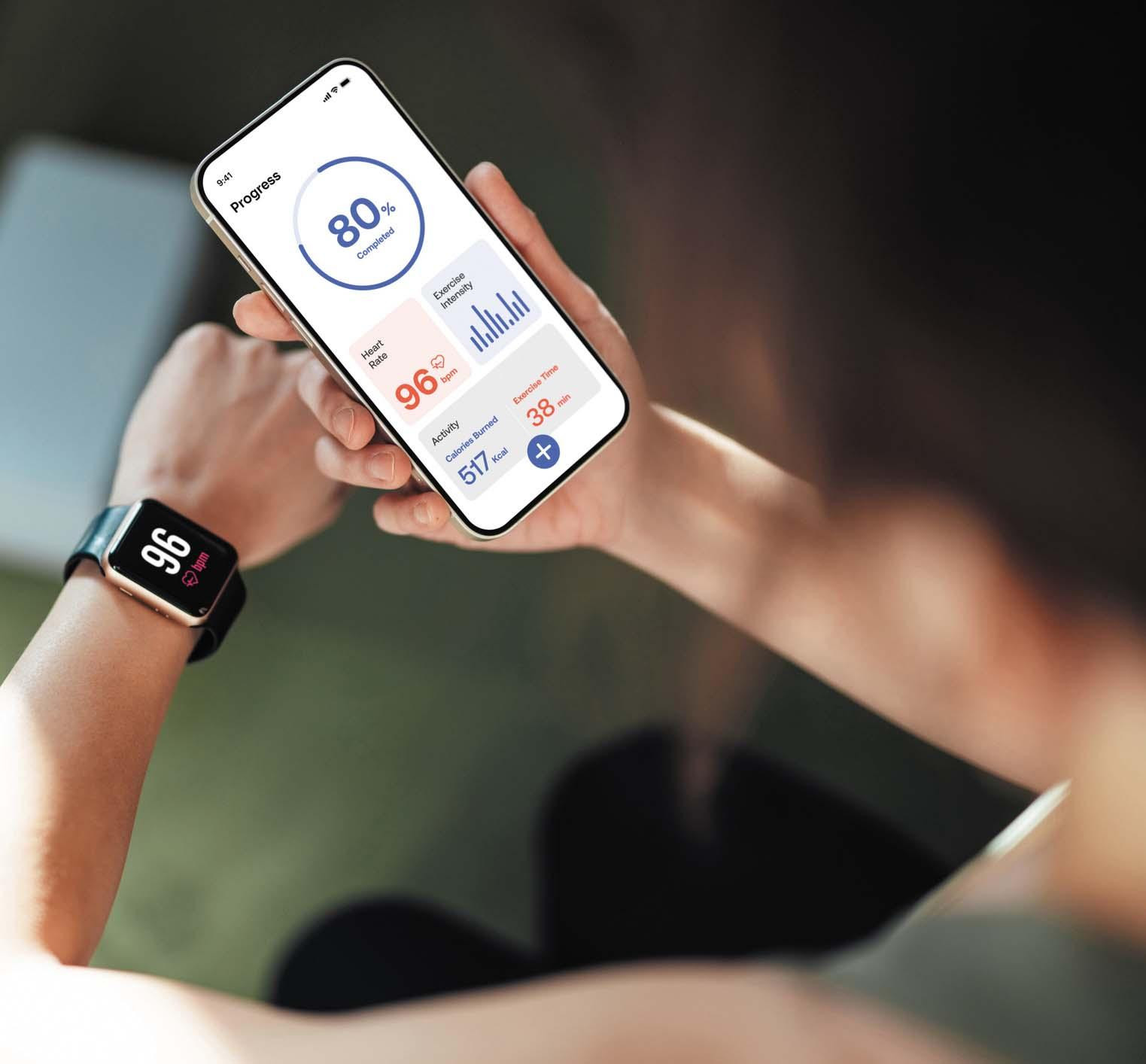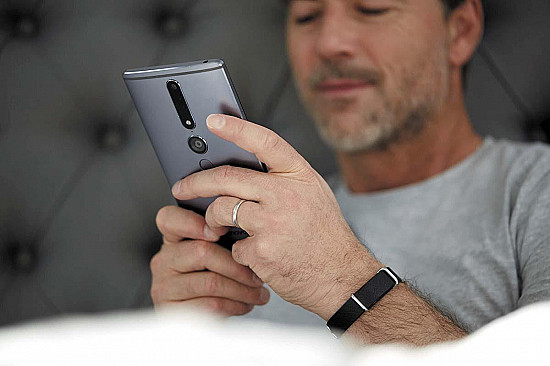Smarter, safer workouts with a wearable fitness tracker
Using a smart watch or similar device can elevate your exercise routine — and help you stay safe if you have heart disease.
- Reviewed by Christopher P. Cannon, MD, Editor in Chief, Harvard Heart Letter; Editorial Advisory Board Member, Harvard Health Publishing

Do you need a little extra inspiration to be more active throughout the day? Or perhaps you’re wondering if your workouts are challenging enough to optimize your cardiovascular health. And if you have any type of heart disease, you’ll want to be sure you’re not pushing yourself too hard during vigorous physical activity. For each of these situations, a wearable fitness tracker may be a worthwhile investment, especially when you consider that exercise is widely considered the best medicine — not just for your heart but for your overall health.
You may already own such a device, as most smart watches include a range of fitness tracking features alongside their other functions. Other options include wrist-worn bands and smart rings that focus primarily on health and fitness tracking.
“The information these wearables provide is measurable, meaningful, and motivating,” says Dr. Sawalla Guseh, director of the Cardiovascular Performance Program at Harvard-affiliated Massachusetts General Hospital. “It’s like having a goal-setting coach with you around the clock,” he says.
Long-term monitoring may also alert you to heart problems, says Dr. Guseh. “I had one patient who didn’t feel chest pain or related symptoms, but he noticed his exercise performance declining over time. It turned out he had coronary artery disease,” he says.
Features to watch
Here are some of the features on wearable fitness devices that are worth checking out.
Stand or move reminders. Many wearables feature customizable notifications — a message on the watch face or a sound or vibration — to remind you to stand up and move around for a short period of time to break up long stretches of sitting. Even dedicated runners need to avoid being sedentary throughout the day to keep their hearts healthy, says Dr. Guseh (see “Stand up for your heart” in the June 2025 Heart Letter).
Daily step counts. Although you’ve likely heard that 10,000 steps per day is a good goal, that number was based on a Japanese marketing scheme and not actual data. Recent evidence finds that a lower number — anywhere from 4,000 to 7,000 daily steps — is linked to improved heart health. A smartphone (provided you carry it with you most of the day) can give a close estimate of your daily step count, but a wearable will be more accurate. Data from your smart watch automatically syncs with your smartphone, and most have apps that display trends in your step counts and other exercise data over weeks, months, and years.
Heart rate zones. Wearables make it easier to assess your exercise effort with heart rate zones, which classify how intensely you’re exercising by measuring your heart rate. The zones are based on your maximum (or peak) heart rate (MHR) — an estimate of the upper limit of what your cardiovascular system can handle during physical activity. A commonly used formula for MHR is 220 beats per minute minus your age, but you should consider this a ballpark figure, since factors other than age are at play.
Different wearables have varied numbers of heart rate zones, although five is typical. Zones 2 and 3 are generally thought to correspond to moderate-intensity exercise, while zones 4 and 5 correspond to vigorous-intensity exercise. But because they’re not individualized, they may not be accurate for everyone, Dr. Guseh notes. Ideally, you should do at least 150 minutes of moderate-intensity exercise, or 75 minutes or more of vigorous-intensity exercise, or an equivalent combination every week.
Heart rate recovery (HRR). This value reflects your heart’s ability to return to its normal, resting pace after you stop exercising. It’s the difference between your peak heart rate during exercise and your heart rate at a set time after you stop (typically one to two minutes). A value of 20 beats per minute is considered good, and higher is even better.
Maximal oxygen consumption (VO2 max). This value is the maximum amount of oxygen a person can use during intense exercise. It can be measured directly when a person runs on a treadmill with an oxygen mask in a lab. Some wearables estimate it based on an algorithm that uses data such as your MHR, HRR, pace, weight, and sex. VO2 max is a powerful predictor of cardiovascular health. “The absolute number may not always be accurate, but the trends can be useful. If your VO2 max rises over time, that’s a strong sign your training is improving your fitness,” says Dr. Guseh.
Heart rate variability (HRV). This value is a measure of the variation in time between heartbeats — differences that are just fractions of a second. More variability (a higher value) suggests better heart health, because it reflects the heart’s ability to respond quickly to rapid changes occurring throughout the body. Most wearables report this value, but there isn’t a recommended target because it varies widely depending on your age, sex, fitness level, and medical history. However, it can be useful to track trends in your HRV over time. HRV often falls after a period or stress or illness but then bounces back — a sign that you’re good to go back to exercising, says Dr. Guseh.
Exercising after a heart disease diagnosisAnyone who’s had a heart attack, heart surgery, or other heart disease diagnosis should attend cardiac rehabilitation, a personalized program of supervised exercise and heart-healthy lifestyle coaching. It starts with an exercise stress test, which involves closely monitoring your heart during exercise to tailor an effective yet safe exercise program for you. “Cardiac rehab is a tried-and-true method of helping people get back into shape, with a standardized protocol that works well for most people,” says cardiologist Dr. Sawalla Guseh, assistant professor of medicine at Harvard Medical School. However, people who were previously exercising at higher intensities and therefore quite fit may get bored at cardiac rehab because it’s too easy for them, he says. If that’s the case for you, consider requesting a referral to a sports cardiologist, who can provide more rigorous and detailed testing and advice, including a specific heart rate threshold you should be careful not to exceed. |
This article is brought to you by Harvard Health Online+, the trusted subscription service from Harvard Medical School. Subscribers enjoy unlimited access to our entire website, including exclusive content, tools, and features available only to members. If you're already a subscriber, you can access your library here.
Image: © Oscar Wong/Getty Images
About the Author

Julie Corliss, Executive Editor, Harvard Heart Letter
About the Reviewer

Christopher P. Cannon, MD, Editor in Chief, Harvard Heart Letter; Editorial Advisory Board Member, Harvard Health Publishing
Disclaimer:
As a service to our readers, Harvard Health Publishing provides access to our library of archived content. Please note the date of last review or update on all articles.
No content on this site, regardless of date, should ever be used as a substitute for direct medical advice from your doctor or other qualified clinician.
















